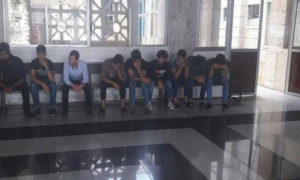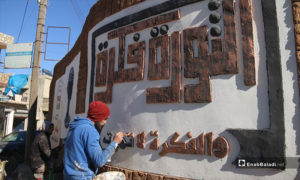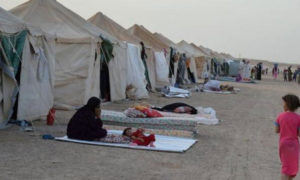
The Syrian local newspapers creating a voice for the revolution – The Guardian,

The Syrian local newspapers creating a voice for the revolution
Civil resistance has flourished thanks to an army of amateur journalists dedicated to keeping the population informed
 Oxygen, a weekly newspaper produced by protesters in Syria, features a lively mix of news, comment and humour. Photograph: guardian.co.uk
Oxygen, a weekly newspaper produced by protesters in Syria, features a lively mix of news, comment and humour. Photograph: guardian.co.ukOxygen, a weekly newspaper produced by protesters in Syria, features a lively mix of news, comment and humour. Photograph: guardian.co.uk
With its comfy sofas and shelves loaded with dictionaries, the living room in Zabadani did not look like the average newsroom. But Rania, who was tapping away on her laptop while calmly but firmly brushing away calls and visitors, made for a fierce editor.
It was a Saturday morning and less than 24 hours before the deadline forOxygen, the local revolutionary newspaper in this quiet farming town in the hills north-west of Damascus. Rania was putting the finishing touches to a piece about the UN observers in Syria.
Twenty-four hours later and Oxygen was hot off the press, printed in another of the town’s revolutionaries’ houses. She and Fadi, an engineer turned printer, critically perused the copies. “The colour could be a little better here,” said Fadi. “I don’t like this article,” said Rania, pointing to one explaining what a light anti-armour weapon is and how to use it, added at the last minute without her knowledge. “The whole point of the magazine is that we are dedicated to peaceful resistance.”
Fifteen months after Syria’s uprising started, the spirit of the revolution has been hidden from view in areas such as Syria’s third city of Homs, where in a spiral of violence from the regime’s shelling and as men from the Free Syrian Army fought back, locals could do little more than try to survive. But the civil resistance movement has gained strength in relatively peaceful areas such as Zabadani.
After months of fighting as the Free Syrian Army men freed the town of 45,000 and then the regime shelled it to regain control, a fragile peace reigned. The army and security forces have checkpoints outside the city, but the space inside the town allowed activism to flourish. Among other things, that took the form of a local newspaper.
The Zabadani team of seven, five women and two men, none of whom are professional journalists, have been putting together their 12-page magazine every week, with the aim of informing locals and trying to keep people from picking up arms. Each issue has included news, essays and a drawing by a local artist. A recent edition’s illustration showed the protesters’ feelings about the chances of success of the UN observer mission: the picture showed President Bashar al-Assad, feet up on his desk, controlling the UN monitors by remote control.
The magazine, in keeping with the wicked sense of humour of Syria’s protesters, has horoscopes with outlooks for various figures in the revolution, from the revolutionaries – “you will no longer fear death” – to the Russians – “you try to dominate in everything … we advise you to think about that more” and the shabiha (roughly translated as thugs) – “you feel there is a disfunction in your genes.”
And Oxygen has not been alone. Since the start of the uprising in March 2011, Facebook groups and online newsletters have flourished. But only more recently have these turned into the professional printed publications that already outstrip Syria’s mainly government-controlled official newspapers in quality. In Daraya, a satellite town close to Damascus known for its peaceful activism before the uprising, Enab Baladi – Local Grape – printed its first edition on 19 January. Salamiyah, a town close to Hama, and the Damascus neighbourhood of Midan also have local newspapers.
“The idea seemed natural after a few months of the revolution,” said Natoor, a 30-year-old member of the group of 15 to 20 who run Daraya’s Enab Baladi, which, like Oxygen, has come out every Sunday. “We needed a space to openly express our thoughts and views,” he said.
This is not something the regime is keen on, as testified by the latest press freedom index by the New York-based Committee to Protect Journalists, which ranked Syria alongside North Korea and Eritrea for media censorship. As the Assad regime has tried to portray the protesters as terrorists, peaceful activists and journalists attracted the wrath of the regime. In Zabadani, one of the security men passed a message to the Oxygen staff warning them to stop printing the magazine. “Pick up weapons, but don’t make things like this,” he was reported to have said. Natoor said the newspaper’s writers, who have other day jobs, had to be careful not to be found out.
Yet threats have not deterred these small newsrooms. Oxygen’s circulation is just 400 but Rania and her team have ambitions to expand and deliver it to other towns as the demand has risen. Locals have become used to it making a regular appearance: two teachers flicked through the paper over tea, while in Zabadani’s orchards men from the Free Syrian Army chuckled at the caricatures. In common with media across the world, Zabadani’s team said the main obstacle was finding the 10,000 Syrian pounds (£110) that it cost to print each edition.
Names have been changed to protect identities
if you think the article contain wrong information or you have additional details Send Correction
-
Follow us :

















 A
A
A
A
A
A







 More Media Coverage
More Media Coverage